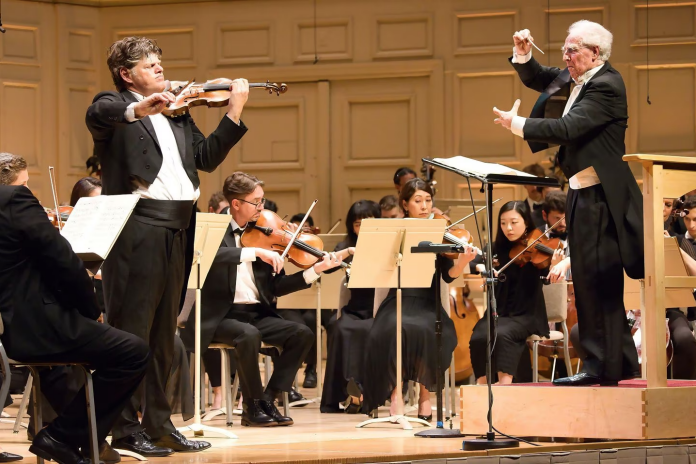Boston Phil starts off 45th season with style

Soloist Guy Braunstein brought strength and sensitivity to the program also featuring Rossini’s William Tell Overture and Beethoven’s Seventh
Edward Elgar’s rarely heard Violin Concerto anchored a tremendous program opening the Boston Philharmonic Orchestra’s 45th season Friday at Symphony Hall. Highly anticipated soloist Guy Braunstein joined forces with the orchestra’s founder and music director Benjamin Zander to guide an energetic audience bravely through the colossal, elaborate work, which was bookended by Rossini’s William Tell Overture and an especially agile Beethoven Symphony No. 7.
Braunstein’s presence generated particular excitement in the hall. He had not performed in Boston in nearly a decade, and Elgar’s concerto is one of the violinist’s longest loves, as Zander shared in a well-attended pre-concert talk. Zander effusively placed Braunstein’s style alongside that of “Golden Age” violinists such as the Elgar’s first recorded soloist, Yehudi Menuhin. Indeed, Braunstein vividly evoked that era with his sensitive tone color, rubato phrasing, and stoic frown.
Braunstein’s distinguished background as a former Berlin Philharmonic concertmaster shone through as he enchantingly wove in and out of the orchestral fabric. Delineating Elgar’s dizzying parade of gorgeous melodies one moment, he drew back into the symphonic texture the next, pooling his sound into the Philharmonic’s as it confidently tackled the intricate score.
In the second movement’s nostalgic sweetness and the third’s pyrotechnics, Braunstein more readily embraced the limelight. That leadership was particularly welcome in the finale, where Elgar’s exceptionally long concerto (approaching 50 minutes) demands the most of its listeners’ stamina, its structure blurred by an avalanche of similar motives, thick orchestration, and virtuosic embellishments. But the magical 11th-hour arrival of an accompanied cadenza — in which remembered fragments of the earlier movements drift hauntingly through the air — drove Braunstein to a lonely, vulnerable lament that seemed to justify the preceding mayhem.
Before the concert, Zander spoke of how the cadenza called to mind his former wife and lifelong friend Rosamund Stone Zander, who died suddenly last month. The ViolinConcerto was one of Elgar’s favorites among his own works, outstripping the Cello Concerto that is far more popular today, and bears an intimate, secret dedication to a close friend. The extended passage, Zander said, was Elgar “not ready to say goodbye” to his concerto’s themes, but a reminder that they live on. Braunstein gave a worthy tribute, a reminiscence in which each note felt like a world.
Rossini’s overture began the evening with eloquent chamber-music turns all around. The opening cello quintet was steered beautifully by Rafael Popper-Keizer and Velléda Miragias, yet the section seemed to move as one organism. In duet with flute Lisa Hennessy, English horn Peggy Pearson kept her Alpine yodeling leisurely and spontaneous rather than emotionally overwrought. The overture’s clarity, conciseness, and familiarity — several musicians were visibly enjoying the famous galop — helped ease listeners into the titanic Elgar.
The same principles in Braunstein’s encore made it a tender relief after the concerto’s overwhelming density. The violinist’s own set of variations on the Beatles’ civil rights movement–inspired “Blackbird” was his reaction to George Floyd’s murder, and retained the folk plainspokenness of the original tune through all its virtuosity.
Zander once again made his case for adhering to Beethoven’s specified tempos in his symphonies, which are often significantly faster than those taken in most performances. That faithfulness alone gave refreshing momentum to the Seventh Symphony’s long introduction and its statuesque chordal outbursts. But enough delicacy remained in that opening to make room for the Allegro’s buoyancy and punch: Zander’s view that the symphony features “dance music from beginning to end” received ample support from the orchestra’s rhythmic consistency and his own animated gestures on the podium. Neither lost any steam across eight minutes of insistent repetition.
In the beloved second movement, the faster tempo left its greatest impression. Rather than a solemn dirge, the music felt closer to a brooding tango — its iconic heartbeat bass line striding across the floor, the companion melody sinuously twisting through the air. The brisker pace gave Zander license to conduct fewer beats and hypnotically employ broader, more fluid motions, all made possible by a palpable shared trust with his players. If the pitter-patter rhythm of the movement’s second half didn’t feel quite comfortable pressing forward at this clip, it successfully transferred its nervous energy into the bubbling scherzo and raucous finale.
It was only natural, then, that the final ovation’s grateful applause converted quickly into synchronized claps, the dance rhythms lingering in our ears.
Click here to view the Concert Program.
Click here to listen to Ben’s Beethoven Symphony no. 7 recording with the Philharmonia Orchestra.
 Leo Sarbanes - The Boston Globe
Leo Sarbanes - The Boston Globe